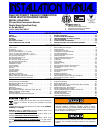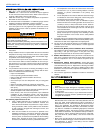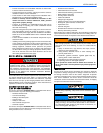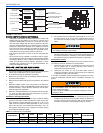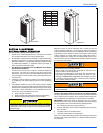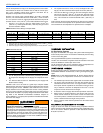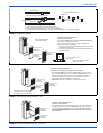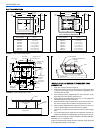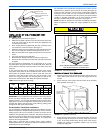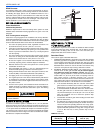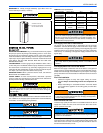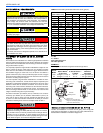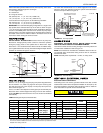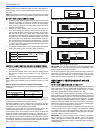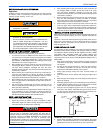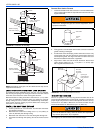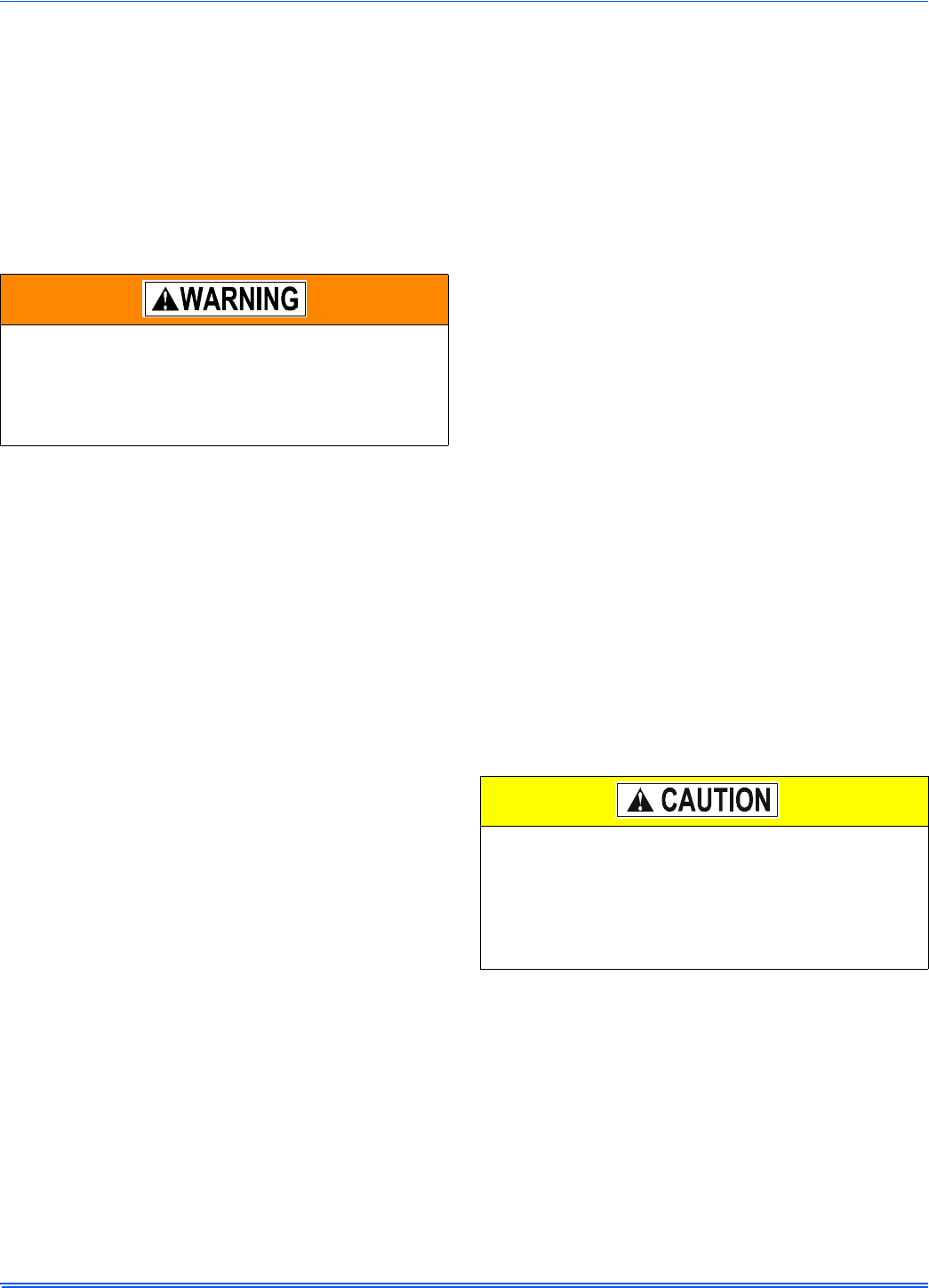
107272-UIM-B-1105
2 Unitary Products Group
SPECIFIC SAFETY RULES AND PRECAUTIONS
1. U.S.....No. 1 or No. 2 heating oil only (ASTM D396),
CANADA.....No. 1 stove oil or No. 2 furnace oil only are approved
for use and can be burned in this furnace. Refer to the furnace rat-
ing plate or SECTION IV of these instructions.
2. Install this furnace only in a location and position as specified in
SECTION I of these instructions.
3. An oil-fired furnace for installation in a residential garage must be
installed as specified in SECTION I of these instructions.
4. Combustion products must be discharged outdoors. The Roof
Jack vent system is the only approved vent system that can be
installed on this furnace. Install as specified in SECTION VI of
these instructions.
5. Test for leaks in the oil line as specified in SECTION VIII of these
instructions.
6. Always install the furnace to operate within the furnace’s intended
temperature rise range. Only connect the furnace to a duct system
which has an external static pressure within the allowable range,
as specified on the furnace rating plate.
7. The return air duct system is not required by the furnace manufac-
turer. This furnace utilizes a sealed combustion air and vent sys-
tem referred to as a roof jack. The Roof Jack must be installed as
specified in these instructions and must conform with state, local,
or regional codes.
8. It is permitted to use the furnace for heating of buildings or struc-
tures under construction. Installation must comply with all manu-
facturer’s installation instructions including:
• Proper vent installation;
• Furnace operating under thermostatic control;
• Return air filter door must be sealed to the furnace;
• Air filters in place;
• Set furnace input rate and temperature rise per rating plate
marking;
• Means for providing outdoor air required for combustion;
• Return air temperature maintained between 55ºF (13ºC) and
80ºF (27ºC);
• The air filter must be replaced or thoroughly cleaned upon sub-
stantial completion of the construction process;
• Clean furnace, duct work and components upon substantial
completion of the construction process, and verify furnace
operating conditions including ignition, input rate, temperature
rise and venting, according to the manufacturer’s instructions.
The following requirements to be met:
a. Clean, outside combustion air is provided to the furnace to
minimize the impact of corrosive adhesives, sealants, and
other construction materials. Drywall dust is a major concern
during construction, which can be pulled into the combustion
air path, leading to plugged heat exchangers, burners, and
inducer assemblies.
b. Filter must be installed in the furnace as specified in the
installation instructions, and must be replaced or thoroughly
cleaned prior to occupancy of the home. Again, drywall dust
is the key issue, as that dust can be pulled into the circulating
blower motor, plugging the motor vents, coating the rotors
and stators, etc. which can lead to a potential fire hazard.
c. The temperature of the return air to the furnace must not be
less than 55° F (13° C), with no evening setback or furnace
shutdown, to prevent condensation in the primary heat
exchangers.
d. The air temperature rise must be within the stated rise range
as indicated on the furnace rating plate, and the firing input
rate must be set to the unit nameplate value.
e. The external static pressure of the air distribution system
ductwork must be set for heating operation to be at least 0.12
(.03 kPA) to 0.30 (0.7 kPA) inches water column, based on
the input rate of the furnace, with the lower value for input
rates at 66,000 btu/hr and the upper value for units with input
rates at 84,000 btu/hr.
f. The furnace and ductwork should be thoroughly and com-
pletely cleaned prior to occupancy of the dwelling to insure
the proper operation of the furnace and to avoid potential
health concerns.
9. In Canada refer to the Oil-fired Central Furnace Installation code,
CANCSA B139 When installed in a Manufactured (Mobile) Home,
combustion air shall not be supplied from occupied spaces.
10. The size of the unit should be based on an acceptable heat loss
calculation for the structure. ACCA, Manual J or other approved
methods may be used.
11. Manufactured (Mobile) Home and Modular Home Installation:
This appliance must be installed in a (sealed combustion) configu-
ration using a roof jack vent system. A roof jack is the only
approved vent system that can be used to vent this appliance.
12. Modular Home Definition: Factory-built home constructed to the
state, local, or regional code where the house will be located. The
home is transported in one or more modules and joined at the
home site.
13. Manufactured (Mobile) Home Definition: Factory-built home
constructed, transported and installed under the federal building
code administered by the U.S. Department of Housing and Urban
Development (HUD Code), rather than to building codes at their
destination. The house is built, transported and installed on a non-
removable chassis.
14. This furnace is approved for installation in trailers or recreational
vehicles.
SAFETY REQUIREMENTS
• A manufactured (mobile) home installation must conform with the
Manufactured Home Construction and Safety Standard, Title 24
CFR, Part 3280, Federal Manufactured Home Construction &
Safety Standard (H.U.D., Title 24, Part 3280) or when such stan-
dard is not applicable, the standard for Manufactured Home
Installations (Manufactured Home Sites, Communities, and Set-
ups) NFPA 31 Installation of Oil-Burning Equipment, CAN/CSA
B139 Installation Codes). This furnace has been certified to the
latest edition of standard UL 727 Standard for Safety for Oil-Burn-
ing Equipment, and for Oil-Fired Central Furnaces (Latest Edi-
tion), CSA B140.10 (Latest Edition), and all local codes and
ordinances.
• Refer to the unit rating plate for the furnace model number, and
then see the dimensions page of these instructions for return air
door dimensions in Figure 2. The filter(s) must be installed
according to the instructions.
FIRE OR EXPLOSION HAZARD
Failure to follow the safety warnings exactly could result in serious
injury, death or property damage.
Read all instructions before proceeding. Follow all instructions com-
pletely. Failure to follow these instructions could result in equipment
malfunction, causing severe personal injury, death, or substantial
property damage.
• Never attempt to alter or modify this furnace or any of its com-
ponents.
• Never attempt to repair damaged or inoperable components.
Such action could cause unsafe operation, explosion, fire and/
or asphyxiation.
• If a malfunction has occurred, or if you feel that the furnace is
not operating as it should, contact a qualified service agency or
oil supplier for assistance.



